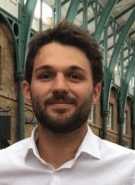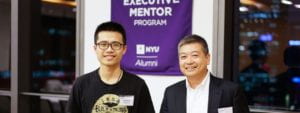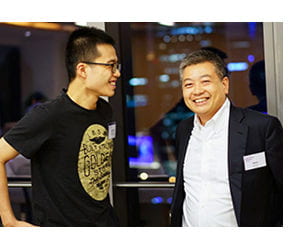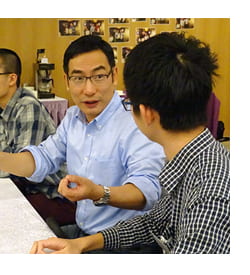Feiran Lyu, current NYU Florence student, was recently in conversation with Andreas Petrossiants,
NYU ´16, Global Liberal Studies. This piece by Feiran shares highlights.
 Andreas Petrossiants is an independent art historian and critic based in New York City. He received an M.A. in art history at the Courtauld Institute of Art in London where his research focused on critical conceptualist art and labor politics of the 1960s. He finished his B.A. at New York University in Global Liberal Studies with a concentration in Arts and Literatures, where he studied at NYU’s La Pietra campus in Florence, Italy for three semesters while researching towards his senior thesis. He is a frequent contributor to The Brooklyn Rail, and has published writing in Senza Cornice, The Daily Serving, among others.
Andreas Petrossiants is an independent art historian and critic based in New York City. He received an M.A. in art history at the Courtauld Institute of Art in London where his research focused on critical conceptualist art and labor politics of the 1960s. He finished his B.A. at New York University in Global Liberal Studies with a concentration in Arts and Literatures, where he studied at NYU’s La Pietra campus in Florence, Italy for three semesters while researching towards his senior thesis. He is a frequent contributor to The Brooklyn Rail, and has published writing in Senza Cornice, The Daily Serving, among others.
What does Dialogue mean to you?
The workshop that I conducted at La Pietra in October was based on a recapitulation of a broad swath of art historical and theoretical methodologies and I would like to continue such an approach for my answers here. That being said, please excuse the overly pedantic—and already well-documented—nature of some responses.
I believe it is safe to say that “dialogue” has taken on two very diverse (and strategic) definitions: one odious and reactionary, the other idealistically emancipatory. Today, we must understand that “dialogue” implies the tacit expectation of an eventual understanding, agreement, or compromise between interlocutors or groups. This potential has become—to my mind—severely overstated and ineffectual. Like other various progressivist tools—such as protest or grassroots activism—dialogue, and its goals, have been usurped by reactionary groups and tendencies to legitimize fringe groups and actions. Such groups have targeted identity politics, “political correctness,” and other strategies of forging and protecting identity, and distorted such protections to say: “our free speech has been infringed upon, we are no longer permitted to say the [horrible] things we would like to say.” That being said, I understand my response seems to be an indictment of free speech, and that is surely the grounds on which a member of such a group would disagree, but my point is only an indictment of hate speech masquerading as legitimate (political) dialogue. This is all to say, sometimes we don’t need to hear “both sides” when what only appears to be legitimate free speech comes into fierce conflict with other civil liberties. This is particularly important to consider given the current economies of clicks, likes, posts and the incredible proliferation of media and information. (A recent talk by Judith Butler, “Limits on Free Speech?” republished on the Verso Books website, is an example of a important way of reconciling all of the above).
All this notwithstanding, I should make clear that I am not referring to “dialogue” in the way La Pietra Dialogues invokes it, both in practice and in name. This is where the emancipatory potential can still function as a very real method for pedagogically bringing attention to what is not right, and to discuss courses of decisive action to counter this. For this reason, I consider LPD to be one of the most important organizations I was lucky enough to engage with as a young student. In many ways LPD stands as an example of the power of free speech, and especially dialogue, to create new discourses, new intersectionality, and new interdisciplinary. It is not farfetched or hyperbolic to say that LPD is a model of programming dialogue that much mass media should take due note from.
What role does contemporary art play today?
This is, perhaps, an even broader question that deserves much more attention than I can presently give—though that is not to say that more than ample attention has not been already been given. Firstly, one must distinguish between the term “contemporary art” as a placeholder for art after year x (the year decided by a particular institutional authority), art made now, and all the other ways of giving the contemporary era a temporal “origin” point—itself a very fraught historiographical action. Some authorities point to the multiple “deaths” of painting in the late 50s; others to the “dematerialization” of the art object coinciding with the “conceptual turn”; others yet, begin with the political activity of May 1968 or the fall of the Berlin Wall and the USSR.
On the other hand, a term like “Postmodernism” denotes a variegated, though still more specific, series of cultural tendencies and models; in the artistic context related to the rejections of authorship, the original artwork’s “authenticity,” and notions of teleological “progress.” See Frederic Jameson’s writings for the term’s early theorization, especially his seminal essay: “Postmodernism, or the Cultural Logic of Late Capitalism.”
The definition of “contemporary,” etymologically at least, has little to do with the way the term is used in branding, historicizing, or spectacularizing art. Take, for example, the recent blockbuster record breaking auction sale of a Leonardo da Vinci painting that made headlines last month. What does this have to do with contemporary art? Not so much. However, it has everything to do with the contemporary hyper-inflated art market, our contemporary era of rampant financial speculation, and so on. So, my roundabout answer can only bring attention to a “broken” dialectic between history and contemporaneity, as they collapse into one another, and to the multiple meanings “contemporary” can take when used as a mechanism for history-writing, as a placeholder for no-longer applicable taxonomies, or as a direct provocation of our everyday. E-flux published a very useful reader titled What is Contemporary Art? (2010) that is a good place to start; I especially recommend Martha Rosler’s “Take the Money and Run? Can Political and Socio-critical Art ‘Survive’?” and Cuauhtémoc Medina’s essay “Contemp(t)orary Art: Eleven Theses,” both in the book.
Another way to approach answering this question is by looking at what is alternately called “socially-engaged art,” social art practice, relational aesthetics, and so on. Claire Bishop’s Artificial Hells, provides a strong critique of the validity of much of the work/theorizing that constitute such tendencies.
This year’s Venice Biennale was (for the most part) yet another startling example of art system escapism in the face of incredibly pressing and disastrous global political circumstances.
What is the relationship between contemporary art and culture?
Again, I worry about answering this question in brief. But a short answer might be that the former commodifies the later or that the former constitutes the latter (in part). The culture industry, as it has been organized, is a complex web of institutions ranging from academia, museums, and kunsthalles, to corporate art firms, auction houses, and for-profit galleries, and furthermore those institutions more distant from the rarefied “art system,” such as political parties, media structures, and so on. The recent (many) controversies following in the wake of documenta 14 are clear examples of the above. In such complicated webs, there are the many goings-on that together produce (mass) culture. But, one must be very careful not to ascribe the entirety of culture to what can be seen, bought, or read in a history book, and to not discredit various cultural phenomena that constitute our contemporary moment. (Once again this word haunts us). It is important to understand who is defining culture and from what position that definition is being produced and subsequently disseminated.
How did your experience in Florence influence or help your work?
This is a very personal response, and might not be the same reading of the city and its multiple cultural scenes that someone else might have. So, get out your grains of salt!
After working for two years at a for-profit art gallery in New York, my move to Florence allowed me to distance myself from a fast-paced profit-centric art system. That is obviously not to say that there are no for-profit galleries in Florence, nor that there is something inherently “wrong” with the concept. Different models of exhibition-making allow for their own specific benefits and hindrances.
My time in Florence allowed me to take in broad sections of the city’s many cultural scenes as a quasi-outsider: I interned at the Fondazione Palazzo Strozzi (before the opening of the Museo Novecento and the arrival of another institution to show modern/contemporary art in Florence), I visited the contemporary section of the wonderful Museo Marino Marini, and got involved in the music scene at venues on the other side of the Arno, and so on. My undergraduate research and thesis-writing—which of course now I would like to amend and takes Florence as a case-study for analyzing how diverse art practitioners define the term “contemporary,” and how it can mean so much and so little at once. Florence’s production of simulacral history or idealized “authenticity” makes it an especially great place to view the culture industry on a smaller scale, and to understand how a façade (even a remarkably beautiful one) can deceive the eye, and can subdue historical analysis for a mystified imaginary. (Professor Lombardo’s course on the histories of urban planning and architecture at NYU Florence was an important introduction to getting past this façade). All that being said, the city was incredibly important for my development, both academically and personally.
In what way does art history help understand contemporary art?
Contemporary art constitutes art history, perhaps at the very moment that it is produced. Though, what is most important is to acknowledge how art history itself is created, consecrated, and venerated. Marcel Duchamp’s famed 1957 lecture “The Creative Act” is a great start. He describes how the spectator, or “art historical posterity,” completes the work of art upon its being viewed, experienced, heard, etc., and how the accompanying process of history-making is very selective. Those who write history create the narratives that are remembered and subsequently taught; but, they also choose those that are potentially “reopened” for historical revisionism and those that are forgotten. This question has only become more relevant as information systems and technology have proliferated in all aspects of life. As the Italian autonomists describe, the primary commodity of our time is information.
What do you think is the major difference between the European contemporary art world and the U.S. contemporary art world?
The major difference is in funding models for art institutions. Many countries in the EU have much higher percentages of their budgets allocated for cultural institutions of all sorts. Of course, the entrenchment of neoliberal economic models in the U.S. and in Europe has meant serious cuts to such public cultural spending in recent decades. Much of the art system in the U.S. is funded by corporate sponsorships, private donors, foundations, and the like; publicly funded projects are few and far between. This model is being applied in many European countries as well, especially now as right-wing governments take political control—either by winning elections, or by shifting policy (and the “center”) further to the right by becoming more extreme.
What do you think is the most important responsibility of art critics nowadays?
There are many that argue that (art’s) criticality, or its potency for any structural change, has been neutralized and made ineffective by an implicit complicity with the systems one critiques. I do not think this interview is the place to grapple with such a broad and difficult claim. I will say, however, that one very important approach (of many) that a critic must take is to shine a light on spaces, artists, groups, and moments that have been traditionally left out of art discourse. It is important to understand the mechanisms at work in creating history, a point that not surprisingly keeps coming up in this interview. For one very important and well-known example, Linda Nochlin’s brilliant and seminal essay, “Why Have There Been No Great Women Artists?” (1971) exemplifies such an approach. We must continue in Nochlin’s path; today, perhaps, more forcefully than ever. We must not shy away from difficult questions.
Read some of Andreas´ recent articles in The Brooklyn Rail:
“José Leonilson: Empty Man”, December 13, 2017
“Resistance Across Time: Interference Archive”, November 2, 2017
And Senza Cornice: Rivista Online di Arte Contemporanea e Critica:
“A Painting by Hans Haacke: Dematerializing Labor”, n. 17, December2017/March 2018
This piece was originally published on the La Pietra Dialogues website and is available here.
 Since 2015, the NYU Alumni Executive Mentorship program has paired dozens of NYU Shanghai students with NYU alumni working in Asia. The program helps students explore professional pathways, while mentors also enjoy the energy and perspectives our students bring. Here, three mentors and their students share their stories, and how it changed their career paths.
Since 2015, the NYU Alumni Executive Mentorship program has paired dozens of NYU Shanghai students with NYU alumni working in Asia. The program helps students explore professional pathways, while mentors also enjoy the energy and perspectives our students bring. Here, three mentors and their students share their stories, and how it changed their career paths. “I was affected by her enthusiasm,” Pan admits. She asked for Naumnik’s thoughts on lowering the characters’ ages from 23–30 to 18–23, Naumnik’s own demographic and Naumnik agreed. She also suggested making the episodes much shorter—around ten minutes—for an internet audience.
“I was affected by her enthusiasm,” Pan admits. She asked for Naumnik’s thoughts on lowering the characters’ ages from 23–30 to 18–23, Naumnik’s own demographic and Naumnik agreed. She also suggested making the episodes much shorter—around ten minutes—for an internet audience. Qingchuan (Kyle) Sang ’18 was torn his sophomore year between chemistry and engineering. He wanted to get the inside scoop on the chemical industry. He chose Mark Yang, NYU Courant ’99, General Manager, Spectra Gases (Shanghai), as a possible mentor. “Mark was working on special gases, producing a reactive gas for medical usage.” Yang introduced Kyle to the chemical engineers working on the project. He took Kyle to a business conference in Beijing to meet the company leaders and give Kyle an inside look at decision-making in his industry. Kyle worked as a translator at the conference. Kyle’s take-away? For now, he feels more comfortable in Research and Development. “I thought the business side would be easier but it’s NOT! Questions like, ‘how big should the factory be; how fireproof do the materials have to be, what should the dirt the factory is built on be composed of’ made me realize that I’m a scientist!”
Qingchuan (Kyle) Sang ’18 was torn his sophomore year between chemistry and engineering. He wanted to get the inside scoop on the chemical industry. He chose Mark Yang, NYU Courant ’99, General Manager, Spectra Gases (Shanghai), as a possible mentor. “Mark was working on special gases, producing a reactive gas for medical usage.” Yang introduced Kyle to the chemical engineers working on the project. He took Kyle to a business conference in Beijing to meet the company leaders and give Kyle an inside look at decision-making in his industry. Kyle worked as a translator at the conference. Kyle’s take-away? For now, he feels more comfortable in Research and Development. “I thought the business side would be easier but it’s NOT! Questions like, ‘how big should the factory be; how fireproof do the materials have to be, what should the dirt the factory is built on be composed of’ made me realize that I’m a scientist!” Like Mark Yang, Danny Bao, CFA, NYU Stern MBA ’01, Managing Director and Chief Investment Officer, HJY Capital Advisors (HK) Limited, had no mentoring experience in his college years. “In my undergraduate study, I had very limited career counseling. I had no idea of how the business world worked! Luckily, J.P. Morgan had a mentoring program.” Bao helps his mentees understand their personal strengths. “I try to move the conversation away from what the student’s parents want. I ask about their hobbies and I try to reduce the gap between the parents’ aspirations and the student’s interests.”
Like Mark Yang, Danny Bao, CFA, NYU Stern MBA ’01, Managing Director and Chief Investment Officer, HJY Capital Advisors (HK) Limited, had no mentoring experience in his college years. “In my undergraduate study, I had very limited career counseling. I had no idea of how the business world worked! Luckily, J.P. Morgan had a mentoring program.” Bao helps his mentees understand their personal strengths. “I try to move the conversation away from what the student’s parents want. I ask about their hobbies and I try to reduce the gap between the parents’ aspirations and the student’s interests.”
